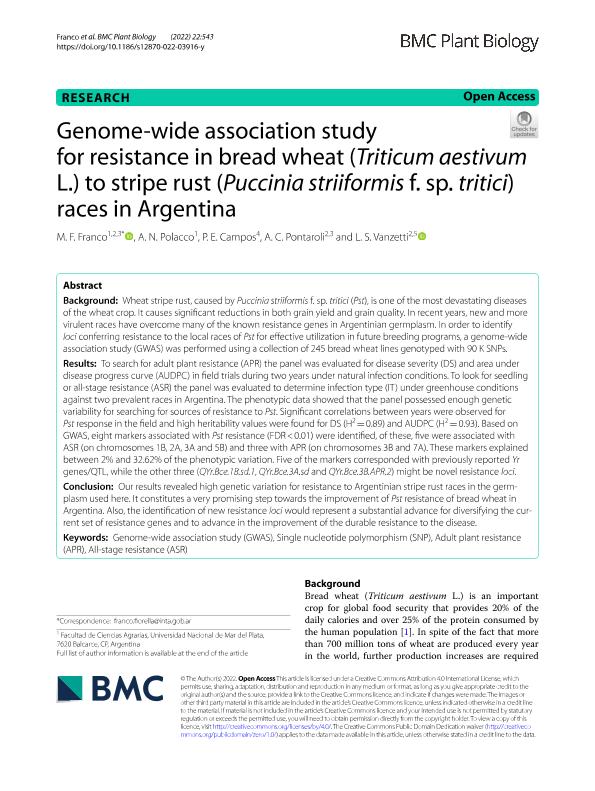Mostrar el registro sencillo del ítem
dc.contributor.author
Franco, María Fiorella

dc.contributor.author
Polacco, A. N.
dc.contributor.author
Campos, P. E.
dc.contributor.author
Pontaroli, Ana

dc.contributor.author
Vanzetti, Leonardo Sebastián

dc.date.available
2023-05-09T13:18:32Z
dc.date.issued
2022-11
dc.identifier.citation
Franco, María Fiorella; Polacco, A. N.; Campos, P. E.; Pontaroli, Ana; Vanzetti, Leonardo Sebastián; Genome-wide association study for resistance in bread wheat (Triticum aestivum L.) to stripe rust (Puccinia striiformis f. sp. tritici) races in Argentina; BioMed Central; BMC Plant Biology; 22; 1; 11-2022; 1-17
dc.identifier.issn
1471-2229
dc.identifier.uri
http://hdl.handle.net/11336/196773
dc.description.abstract
Background: Wheat stripe rust, caused by Puccinia striiformis f. sp. tritici (Pst), is one of the most devastating diseases of the wheat crop. It causes significant reductions in both grain yield and grain quality. In recent years, new and more virulent races have overcome many of the known resistance genes in Argentinian germplasm. In order to identify loci conferring resistance to the local races of Pst for effective utilization in future breeding programs, a genome-wide association study (GWAS) was performed using a collection of 245 bread wheat lines genotyped with 90 K SNPs. Results: To search for adult plant resistance (APR) the panel was evaluated for disease severity (DS) and area under disease progress curve (AUDPC) in field trials during two years under natural infection conditions. To look for seedling or all-stage resistance (ASR) the panel was evaluated to determine infection type (IT) under greenhouse conditions against two prevalent races in Argentina. The phenotypic data showed that the panel possessed enough genetic variability for searching for sources of resistance to Pst. Significant correlations between years were observed for Pst response in the field and high heritability values were found for DS (H2 = 0.89) and AUDPC (H2 = 0.93). Based on GWAS, eight markers associated with Pst resistance (FDR < 0.01) were identified, of these, five were associated with ASR (on chromosomes 1B, 2A, 3A and 5B) and three with APR (on chromosomes 3B and 7A). These markers explained between 2% and 32.62% of the phenotypic variation. Five of the markers corresponded with previously reported Yr genes/QTL, while the other three (QYr.Bce.1B.sd.1, QYr.Bce.3A.sd and QYr.Bce.3B.APR.2) might be novel resistance loci. Conclusion: Our results revealed high genetic variation for resistance to Argentinian stripe rust races in the germplasm used here. It constitutes a very promising step towards the improvement of Pst resistance of bread wheat in Argentina. Also, the identification of new resistance loci would represent a substantial advance for diversifying the current set of resistance genes and to advance in the improvement of the durable resistance to the disease.
dc.format
application/pdf
dc.language.iso
eng
dc.publisher
BioMed Central

dc.rights
info:eu-repo/semantics/openAccess
dc.rights.uri
https://creativecommons.org/licenses/by/2.5/ar/
dc.subject
ADULT PLANT RESISTANCE (APR)
dc.subject
ALL-STAGE RESISTANCE (ASR)
dc.subject
GENOME-WIDE ASSOCIATION STUDY (GWAS)
dc.subject
SINGLE NUCLEOTIDE POLYMORPHISM (SNP)
dc.subject.classification
Agricultura

dc.subject.classification
Agricultura, Silvicultura y Pesca

dc.subject.classification
CIENCIAS AGRÍCOLAS

dc.title
Genome-wide association study for resistance in bread wheat (Triticum aestivum L.) to stripe rust (Puccinia striiformis f. sp. tritici) races in Argentina
dc.type
info:eu-repo/semantics/article
dc.type
info:ar-repo/semantics/artículo
dc.type
info:eu-repo/semantics/publishedVersion
dc.date.updated
2023-05-09T11:48:34Z
dc.journal.volume
22
dc.journal.number
1
dc.journal.pagination
1-17
dc.journal.pais
Reino Unido

dc.journal.ciudad
Londres
dc.description.fil
Fil: Franco, María Fiorella. Universidad Nacional de Mar del Plata. Facultad de Ciencias Agrarias; Argentina. Instituto Nacional de Tecnología Agropecuaria. Centro Regional Buenos Aires Sur. Estación Experimental Agropecuaria Balcarce; Argentina. Consejo Nacional de Investigaciones Científicas y Técnicas; Argentina
dc.description.fil
Fil: Polacco, A. N.. Universidad Nacional de Mar del Plata. Facultad de Ciencias Agrarias; Argentina
dc.description.fil
Fil: Campos, P. E.. Instituto Nacional de Tecnología Agropecuaria. Centro Regional Buenos Aires Sur. Estación Experimental Agropecuaria Bordenave; Argentina
dc.description.fil
Fil: Pontaroli, Ana. Instituto Nacional de Tecnología Agropecuaria. Centro Regional Buenos Aires Sur. Estación Experimental Agropecuaria Balcarce; Argentina. Consejo Nacional de Investigaciones Científicas y Técnicas; Argentina
dc.description.fil
Fil: Vanzetti, Leonardo Sebastián. Consejo Nacional de Investigaciones Científicas y Técnicas; Argentina. Instituto Nacional de Tecnología Agropecuaria. Centro Regional Córdoba. Estación Experimental Agropecuaria Marcos Juárez; Argentina
dc.journal.title
BMC Plant Biology

dc.relation.alternativeid
info:eu-repo/semantics/altIdentifier/url/https://bmcplantbiol.biomedcentral.com/articles/10.1186/s12870-022-03916-y
dc.relation.alternativeid
info:eu-repo/semantics/altIdentifier/doi/http://dx.doi.org/10.1186/s12870-022-03916-y
Archivos asociados
